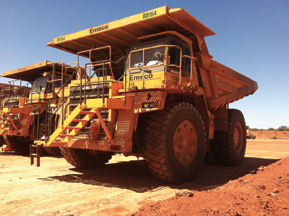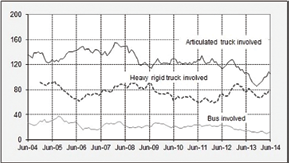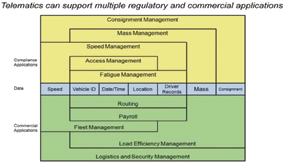Over the last decade or so Australia, like many other countries, has moved to ever more vigilance in the safety of transport drivers, especially on long hauls.
The number of accidents involving heavy vehicles has failed to dramatically improve. The graph below shows that although there has been consistent movement on articulated transport recently, rigid vehicles are still hovering at the same disastrous levels as a decade ago.
KORE Wireless partner, Melbourne-based Mobile Tracking and Data Pty Ltd (MTData), has been working on solutions to these challenges for some time. Coming from a background in providing some of the first and most ubiquitous two-way radio based, taxi dispatch terminals during the 1980s and 1990s, the MTData team first worked with a cellular based set of solutions, which has again become a dominant feature of the taxi dispatch market. In the last year or two they have turned their attention to Australia’s Transport Certification (IAP/TCA) and compliance challenges.
MTData have developed a solution which combines cellular and satellite connectivity to address a range of issues that are common to the fleet tracking industry such as compliance with OH&S regulations, Driver safety and vehicle management. Put simply from a device view, they have developed a number of algorithms that detect when cellular coverage has been dropped for a certain amount of time and, if that connection cannot resume, it then switches to satellite mode to operate. The satellite connection uses Iridium’s Short Burst Data (SBD) service. To explain how this works, we often compare SBD to sending an SMS message (if, say, something such as Inmarsat’s BGAN service is a 3G or GPRS equivalent, for example).
The challenge for MTData in using SBD for this operation is that it functions in a different way from how the devices normally work in cellular mode. SBD sends messages limited to—usually under—1000 bytes at a time, with no headers (well, no chargeable headers, in any case). This means that the data payload has to be extracted and treated separately from the data delivered by terrestrial networks and, in fact, arrives via a different path.
KORE delivers these messages to MTData’s servers via our IP Gateway, a service that takes these SBD text messages and delivers them in a format and method that can be successfully integrated into the IP data stream from cellular. It’s like having dedicated VPN delivery of text messages that can be delivered as a TCP/IP Packet, or xml, or other formats suited to IP transactions. The positive side of this type of delivery, is that the messages are limited in size, so it is much harder to send very large (=expensive) amounts of data over SBD.
A key part of the MTData solution is to ensure that only essential data is relayed in real-time over satellite. Other important, but not time critical, data can be reserved for sending over the more cost effective cellular signal when the vehicle reaches terrestrial coverage. Vitally important is obtaining the correct balance—sending the critical information as necessary and holding the balance for later. Failing to get this right can mean either a dangerous situation is left unattended for an extended period, such as driver fatigue or an engine alert. On the other hand, sending all of the data can mean expensive satellite data costs.
KORE has created specific pooled SBD data plans for MTData that enable data usage from multiple users to be aggregated into a single billing pool. Take, for example, large trucking fleet companies who rotate their trucks to maximize mileage across the fleet. Bundled (pooled) plans can manage the data between these trucks across the fleet. This means there is a significant reduction in price—if one truck is resting, the other truck effectively uses “its” monthly data, as all the data is shared.
The key result is a significant savings for the customer. This work around has directly resulted in a dramatic price drop for the customer who previously had to select which trucks to put the devices in, leaving some of the fleet vulnerable.
Due to what has become effectively a significant price drop, they can now place devices in all their trucks to comply with OH&S (Occupational Health & Safety) regulations and maximize driver safety. There is a small possibility they will go over their individual data allowances, which used to be a very high rate, but now with pooling, this is unlikely to happen and, if it does, the cost is significantly lower overall.
Direct applications for this solution include:
• OH&S regulations
Compliance is particularly beneficial in the mining industry, where drivers need to be tracked constantly (as above per the TCA system).

Driver alerts / fatigue regulations
To address these situations, the system sends a message to the driver to alert them that they need to take a break. The driver takes his break and logs it in the system, which sends a message to the base to confirm that the required break was taken. This is beneficial for compliance and is also essential to ensure driver safety and well-being.
• Duress alarms
A switch located in vehicle’s cabin sends an urgent alert via satellite to the base to request someone be sent directly to the vehicle to assist the driver.
• Man down alarms
The driver has a pendant that, if activated, reports the location to base so they can send someone to assist immediately. This is especially useful if loading or unloading at a remote terminal that may be unmanned. This allows more much more efficient allocation of staff, without compromising safety.
• Engine critical alarms
In many systems, it is highly desirable to incorporate interfaces into the vehicles EMS (Engine Management System)—these are, after all, hundreds of thousands to multimillion dollar assets. Timely alarming can be the difference between a tow truck fee and a complete new engine in, for example, an overheating situation, or between recapping or replacing a worn tire (Mining truck tires can cost many thousands of dollars).
 —Improves efficiency through integrated dispatching and transport systems software integration
—Improves efficiency through integrated dispatching and transport systems software integration
The pooling of ideas and technology between software, hardware and communications providers—both satellite and cellular—has led to a reliable, comprehensive and integrated transport safety management system that:
—Ensures that transport operators’ legal obligations are fulfilled
—Improves Driver road safety and lessens accidents through effective fatigue management
—Allows for much improved maintenance and life of assets (trucks/tires etc.) through effective alarming and targeted preventative maintenance programs
—Has lowered operational costs by such a significant amount that the solution can be rolled out through entire fleets
—Combines the cost effectiveness of terrestrial networks with the superb coverage performance of satellite to give “go anywhere” peace of mind to drivers and transport operators
The solution that MTData and KORE has developed is an example of harnessing the ever-evolving power of technology. By creating and implementing a reliable, cost-effective and practical solution, MTData have addressed the critical issues of safety and performance that are vitally important to the fleet logistics industry. With continuing advances in M2M technology enabling the ability to combine the best of satellite and cellular, it won’t be long before we see many more operators taking advantage of the complementary technologies to improve their businesses.

To learn more about the MTData solutions fleet tracking solution, please visit: http://www.mtdata.com.au/
For additional information regarding KORE Wireless solutions: http://www.korewireless.com/au
Shane Murphy is the Vice President and General Manager of KORE Wireless, the world’s largest M2M provider. He is an accomplished business strategist and development executive with extensive experience in mobile communications, commercial two way radio, M2M and the Internet of Things.




